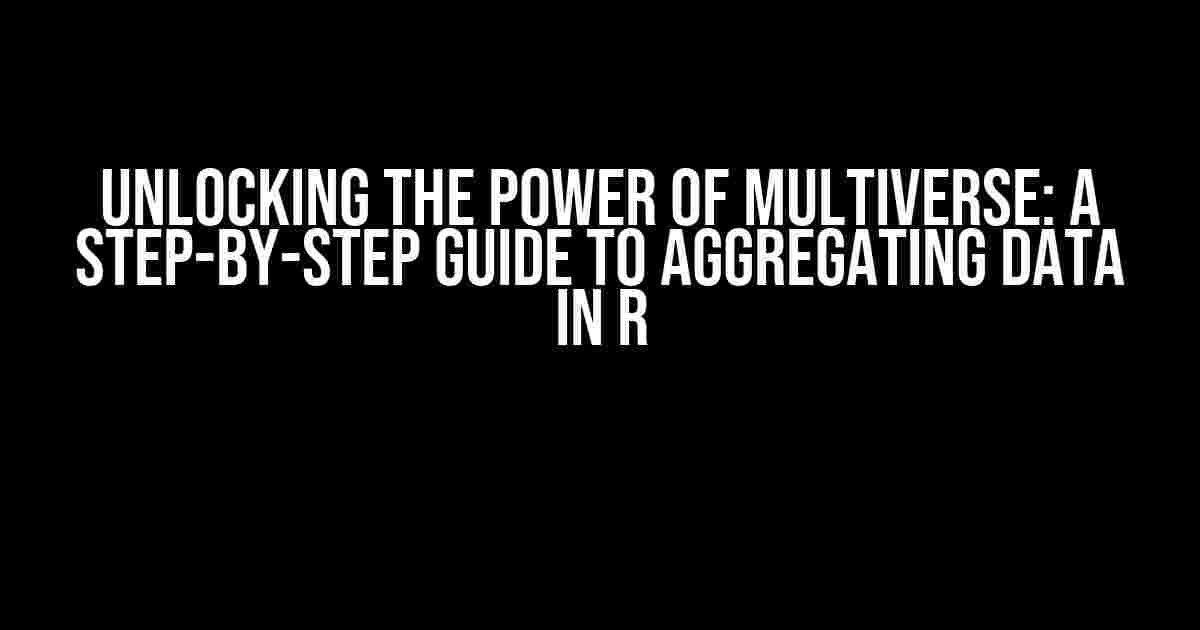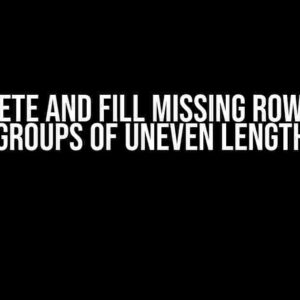Are you tired of struggling to analyze and visualize complex datasets within the multiverse package in R? Do you want to unlock the full potential of this powerful tool and take your data analysis to the next level? Look no further! In this comprehensive guide, we’ll walk you through the process of aggregating data within the multiverse package in R, providing clear and direct instructions, explanations, and examples to get you started.
What is the Multiverse Package?
The multiverse package is an R package designed to facilitate the exploration and analysis of complex datasets. It provides a comprehensive framework for working with multiverse datasets, which are datasets that contain multiple, potentially conflicting, data sources. The package offers a range of tools and functions for data manipulation, visualization, and analysis, making it an essential tool for data scientists and analysts working with complex datasets.
Why Aggregate Data within the Multiverse Package?
Aggregating data within the multiverse package is essential for several reasons:
- Simplifies data analysis**: Aggregating data reduces the complexity of the dataset, making it easier to analyze and visualize.
- Improves data quality**: Aggregating data helps to eliminate inconsistencies and errors, resulting in higher-quality data.
- Enhances data insights**: Aggregated data provides a more comprehensive view of the dataset, enabling the identification of patterns and trends that may not be apparent in individual data sources.
- Facilitates data visualization**: Aggregated data can be visualized more effectively, allowing for better communication of results and insights.
Preparing Your Data for Aggregation
Before aggregating your data, it’s essential to prepare it for analysis within the multiverse package. Here are the steps to follow:
- Install and load the multiverse package**: Install the multiverse package using the following command:
install.packages("multiverse"). Then, load the package usinglibrary(multiverse). - Import your dataset**: Import your dataset into R using the
read.csv()orread.table()function, depending on the format of your data. - Convert your dataset to a multiverse object**: Convert your dataset to a multiverse object using the
as.multiverse()function.
# Install and load the multiverse package
install.packages("multiverse")
library(multiverse)
# Import your dataset
data <- read.csv("your_data.csv")
# Convert your dataset to a multiverse object
data_multiverse <- as.multiverse(data)
Aggregating Data within the Multiverse Package
Now that your data is prepared, it's time to aggregate it! The multiverse package provides several aggregation functions, including:
- summarize()**: Calculates summary statistics (e.g., mean, median, standard deviation) for each variable in the dataset.
- aggregate()**: Aggregates data by one or more variables, using functions such as sum, mean, or count.
- merge()**: Merges multiple datasets into a single dataset, allowing for the aggregation of data from multiple sources.
Example 1: Aggregating Data using summarize()
Let's say we want to calculate the mean and standard deviation of a variable called "score" in our dataset. We can use the summarize() function to achieve this:
# Calculate the mean and standard deviation of the "score" variable
data_summary <- summarize(data_multiverse,
mean_score = mean(score),
sd_score = sd(score))
# Print the results
print(data_summary)
Example 2: Aggregating Data using aggregate()
Suppose we want to aggregate the "score" variable by a categorical variable called "group". We can use the aggregate() function to achieve this:
# Aggregate the "score" variable by the "group" variable
data_aggregated <- aggregate(score ~ group,
data_multiverse,
FUN = mean)
# Print the results
print(data_aggregated)
Example 3: Merging Multiple Datasets using merge()
Let's say we have two datasets, "data1" and "data2", that we want to merge into a single dataset. We can use the merge() function to achieve this:
# Merge the two datasets
data_merged <- merge(data1_multiverse,
data2_multiverse,
by = "id")
# Print the results
print(data_merged)
Visualizing Aggregated Data
Once your data is aggregated, you'll want to visualize it to gain insights and identify patterns. The multiverse package provides a range of visualization tools, including:
- plot()**: Creates a variety of plots, including scatterplots, bar charts, and histograms.
- ggplot()**: Provides a grammar-based approach to data visualization, allowing for the creation of complex and customized plots.
Example: Visualizing Aggregated Data using plot()
Let's say we want to create a bar chart to visualize the mean score for each group. We can use the plot() function to achieve this:
# Create a bar chart to visualize the mean score for each group
plot(data_aggregated,
main = "Mean Score by Group",
xlab = "Group",
ylab = "Mean Score")
Conclusion
Aggregating data within the multiverse package in R is a powerful way to simplify complex datasets, improve data quality, and enhance data insights. By following the steps outlined in this guide, you can unlock the full potential of the multiverse package and take your data analysis to the next level. Remember to prepare your data, choose the right aggregation function, and visualize your results to gain meaningful insights.
| Function | Purpose |
|---|---|
| summarize() | Calculates summary statistics for each variable in the dataset. |
| aggregate() | Aggregates data by one or more variables, using functions such as sum, mean, or count. |
| merge() | Merges multiple datasets into a single dataset, allowing for the aggregation of data from multiple sources. |
By mastering the art of aggregating data within the multiverse package, you'll be able to tackle even the most complex datasets with confidence. Happy data analyzing!
Frequently Asked Question
Get answers to the most commonly asked questions about aggregating data within the multiverse package in R.
How do I aggregate data within the multiverse package in R?
To aggregate data within the multiverse package in R, you can use the `summarise()` function from the `dplyr` package. This function allows you to apply aggregation functions such as `mean()`, `sum()`, and `count()` to your data. For example, if you want to calculate the mean of a column `x` in your data, you can use `summarise(mean_x = mean(x))`. Make sure to load the `dplyr` package before using the `summarise()` function.
Can I aggregate data by groups using the multiverse package in R?
Yes, you can aggregate data by groups using the multiverse package in R. To do this, you can use the `group_by()` function from the `dplyr` package in combination with the `summarise()` function. For example, if you want to calculate the mean of a column `x` by a grouping variable `y`, you can use `group_by(y) %>% summarise(mean_x = mean(x))`. This will give you the mean of `x` for each level of `y`.
How do I handle missing values when aggregating data using the multiverse package in R?
When aggregating data using the multiverse package in R, you can handle missing values using the `na.rm` argument in your aggregation functions. For example, if you want to calculate the mean of a column `x` and ignore missing values, you can use `summarise(mean_x = mean(x, na.rm = TRUE))`. This will remove any missing values from the calculation.
Can I use custom aggregation functions with the multiverse package in R?
Yes, you can use custom aggregation functions with the multiverse package in R. To do this, you can define your own function and use it within the `summarise()` function. For example, if you want to calculate the median of a column `x`, you can define a `median` function and use it like this: `summarise(median_x = median(x))`. Make sure to define your custom function before using it in the `summarise()` function.
Can I aggregate data across multiple universes using the multiverse package in R?
Yes, you can aggregate data across multiple universes using the multiverse package in R. To do this, you can use the `aggregate()` function from the `multiverse` package. This function allows you to apply aggregation functions to data across multiple universes. For example, if you want to calculate the mean of a column `x` across multiple universes, you can use `aggregate(x, FUN = mean)`. This will give you the mean of `x` across all universes.


